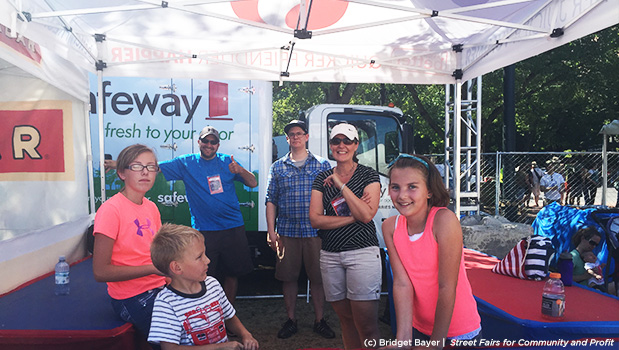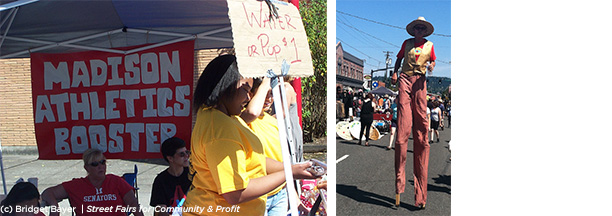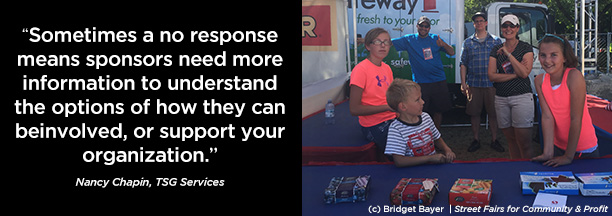Main Spotlight: Connecting, Innovating, and Sustaining a Healthy Main Street Movement
Key takeaways from six sessions at the 2025 Main Street Now Conference.

This is the third article in a three-part series by street fair expert Bridget Bayer. Be sure to check out her other two articles.
Create an outline for your Street Fair by asking your planning committee these 10 questions. The outline process only has to happen once each year. It might take some time at the beginning, but will save effort, and probably money, when issues or more questions arise in the future.
Plan a few coffee breaks or group meetings to consider these questions and make sure write down your thoughts!
GOALS: What realistic goals are expected?
PARTNERS: Who is involved? Who manages information, activities, operations?
BENEFIT: What for?
AUDIENCE: Who comes, attends, or is the target market?
ACTIVITIES: What happens?
FUNDING: Who pays? How much will it cost?
SETTING: When is the best time and date? Where will it take place?
THEME: What’s new?
NAME: What is it called?
MISSION: Why is it worth the effort?

Partnerships create long-term successful communities; What happens at your Fair depends on who you invite
Why have a street fair? What are the goals of the fair? How will a street fair fill or satisfy your goals? Spend time reaching consensus on this. There can be several worthy goals.
Try narrowing down to one goal to start.
Goal Examples:
• Improve neighborhood
• Increase community connections
• Build circular economy
• Attract new people
• Thank customers or neighbors
• Brand or create an identity
Many small businesses think about more than just net profits. The triple bottom line of sustainability calls for profitably in social equity and environmental benefits, besides monetary profits.
Street fairs have a way of “giving back” by raising funds for local schools, supporting community groups, the environment and local long-term jobs, among other benefits.
Consider the businesses, property owners, community members and non-profits in your area. This list is often referred to as stakeholders. Would any of them benefit from partnering with your organization? Will the businesses in your area support the fair? Who might want to have a public face on street fair day? Would they add something special? Think about the big businesses outside your immediate vicinity or suppliers to businesses in the area. They may also have considerable interest your area’s success.
Partners are the ideal planning committee members. Seek a split of long-term locals and “newbies” who bring energy and enthusiasm. Owners who have been in the area for a long time have historical knowledge. They are the “wise ones” with valuable and enduring relationships. New business owners bring fresh ideas, plus often attract young shoppers.
A street fair can benefit participating individuals or community non profit groups, giving them the opportunity to be recognized by a large audience.
Do any of these groups serve your target market? Does their work make the grade in your area? What would the neighborhood be like without them? It’s okay not to have a beneficiary, too.
Why plan to throw a fabulous party if no one is invited? The first step to promote your Street Fair is to define your target market. It’s important to narrow your focus because marketing is one of your biggest expenses.
Who are your customers, or who shops in your area? Who do you want to know about your businesses? These are your target markets. Compare lists with others to come up with a primary target market for your fair.
Identify larger destination stores in your area. Small, unique, specialty businesses can also be destination businesses. Destination stores, also known as “anchors,” are well recognized and persuade customers to go out of their way to shop there. Make sure destination business’ customers are added to your target market list.
Once a target market has been identified, describe their demographics. How old are they? What’s their income level, education, nationality or ethnicity? Are they seniors, teens or singles? Do they have many pets?
What’s most important about them is how they get information. Where do they find out about events? What do they read, listen to or watch? Who influences them? You may end up with several target market segments defined.
Your planning efforts will vary depending on the activities at your Fair.
What does your target audience want:
• To shop?
• Play games?
• Listen to music?
• Play kids’ activities?
Consider what your target market wants to experience or what might be exciting to them. Ideas for activities can come from a SWOT analysis that looks at your community’s strengths, weakness, opportunities and threats (or challenges.) Discover what works, what doesn’t, what’s already going on and why. Show off your area simply by highlighting the best of your community.
Another effective way to consider which activities to include is by drawing a large scale map. It may help committee members visualize your area and stimulate ideas for activities.
Consider your “earned media” potential at this time. This is publicity gained through promotional efforts other than paid advertising when considering types of activities at your fair think about:
• What does the media like to cover?
• What kind of stories are found in your news?
An annual street fair usually maintains the same activities, year after year, and attendees will look forward to their favorite ones. This also helps keep costs low by relying on the same information, signs, equipment, etc.. New partners will often bring new ideas for activities keeping your Fair fresh and interesting.

An ideal way to pay for a street fair is to divide costs among partners. Shoot for a magic triangle of support from sponsors, members and street vendors.
Sponsorship and donations that contribute financially to help pay for fair expenses usually come from business and property owners. Contributions can also be in-kind, reducing the cost of the event. In-kind contributions will also reduce the overall cost of a fair.
Grants from local foundations, government economic development agencies and arts organizations might offer funding in your community. They often support activities within the fair.
Sales, entry fees, T-shirt sales, food, beer mugs, souvenirs, raffles and contests can also bring in funding.
Contests are often a good source of revenue when everything works, but contests are one of the least reliable strategies for fundraising. Entice community groups to be partners by allowing them to host contests that raise funds for their own organizations. Fifty-fifty raffles, classic autos, bikes, art or vacation packages are great “big ticket” items that draw in crowds.
When? Set the date, location and time. Planning takes at least 6 months to a year. Check events calendars and avoid similar events. Consider your proposed target market when choosing the date. This does not have to be permanent. Adjust as needed until the best date is found.
Date considerations:
• National Holidays
• Local annual events
• Sports games (national too)
• Temperature (for activities)
• Retail sale dates
• School schedules
• Traffic
Where? Ideally stage your Fair on your main street. The location for your fair might be set already by the area in which most businesses exist. It could feature hidden areas or those not yet fully appreciated.
Street fairs are packed with activities. These entertaining activities can be located on every block or only select places. They can vary widely but be sure to consider the pedestrian’s ability to walk the area.
If your area is larger than 10 blocks, consider scheduling the event on a weekend or on a series of days. Also, try leaving a lane clear of any activity or equipment and run a trolley, bus, shuttle or pedi-cabs, allowing pedestrians to move without having to walk.
Save space for:
• Activities
• Entry points & lines
• Garbage & recycling
• Rest stops
• ATMs
• Rental toilets
If it’s your first Street Fair, make sure to consider:
• Where are the natural, inherent places that allow positive experiences?
• Who is involved that might want to host an activity?
• What kind of activity would fit the space?
Our culture loves something new. “News” sells because readers are looking for something they don’t already know. It is beneficial to offer a different theme each year to continue to draw interest. For best results, focus on:
• Area uniqueness
• Associations & partnerships
• Special draw
• Historical event
• Famous people
Consider fair activities, your target market, the beneficiary, the season, a holiday--or something wacky, yet alluring, that will help develop interest in the street fair year after year. Use your imagination!

The Longest Lemonade Stand was the theme then became the name of this event
Describe your Fair in its name. A classic method of naming a Street Fair is to base it on geography or content. Be descriptive of either where the Fair is located or what it is about. Search for something that is enduring and easily recognizable. A name that uses alliteration is something our human brains can easily remember.
Geographic Examples:
• Your Street Fair
• Shoreline Street Fair
• Upper Lower Street Fair
• Lawrence Street Fair
• 22nd Avenue Art Fair
• 4th Street Fabulous Fun Fest
A mission statement often surfaces through the process of considering the Street Fair outline questions. Business people know that it’s easier to write a mission statement after writing a business plan. Similarly, now that all the above questions have been considered, it will be easier to describe why your Street Fair is worth the expense and effort.
This statement should be reconsidered each year, at the start of planning process, with as many stakeholders or partners as possible. It’s good practice to have someone articulate the mission at the start of all subsequent planning meetings.
Examples: “OUR STREET FAIR MISSION...
• …is to celebrate diversity”
• …is to raise funds that support our member activities throughout the year”
• …builds community through participation”
• …is to guide, nurture and protect the culture of our community”
• …creates a distinct identity for our district”
Read the other two street fair articles: Building Community Through Street Fairs: Identifying Community Assets and Building Community Through Street Fairs: Eight Fundraising Tips for Making Your Street Fair Profitable.
Over the past two decades, Bridget Bayer has lived and breathed community development—from building and running her own small businesses, to working with more than 20 business associations in the Portland metro area—to managing and training over 1,500 volunteers. Her company, BAM, (Business Association Management) is a consulting firm that helps build community through events, raise funds and enhance the visibility of main streets and community groups.
One of the founders and hands-on organizer of the wildly successful Mississippi Street Fair, Bayer is bringing her considerable community-building skills and experience to a wider audience with a new book, Street Fairs for Community and Profit. The guidebook focuses on how to strengthen a community and profit by it through effective planning and executing sensational street fairs.